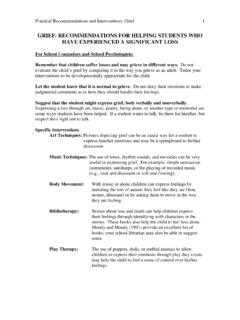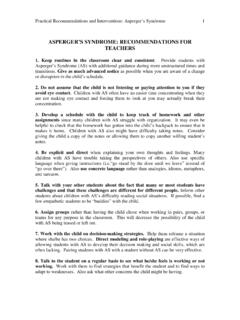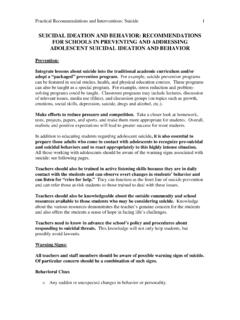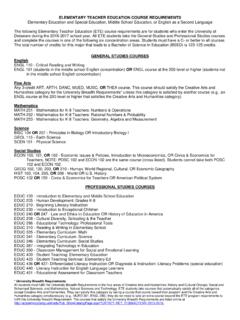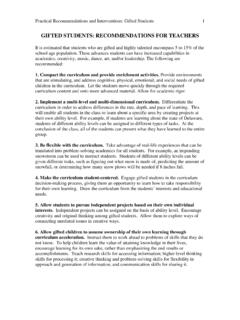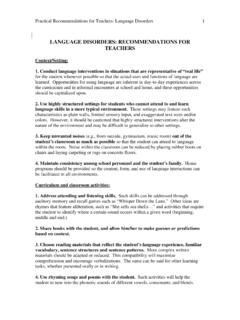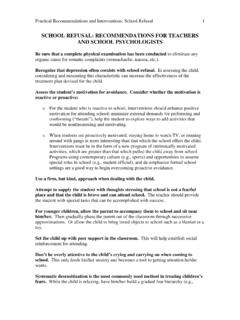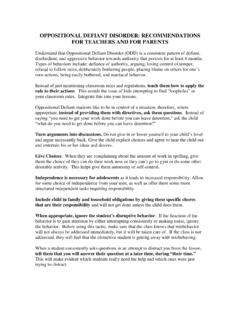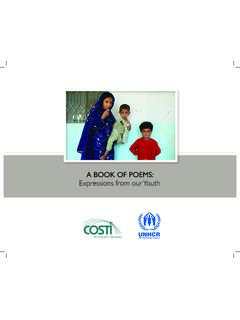Transcription of LANGUAGE DISORDERS: RECOMMENDATIONS FOR …
1 Practical RECOMMENDATIONS for Teachers: LANGUAGE disorders 1 LANGUAGE disorders : RECOMMENDATIONS FOR TEACHERS Context/Setting: 1. Conduct LANGUAGE interventions in situations that are representative of real life for the student whenever possible so that the actual uses and functions of LANGUAGE are learned. Opportunities for using LANGUAGE are inherent in day-to-day experiences across the curriculum and in informal encounters at school and home, and these opportunities should be capitalized upon. 2. Use highly structured settings for students who cannot attend to and learn LANGUAGE skills in a more typical environment.
2 These settings may feature such characteristics as plain walls, limited sensory input, and exaggerated text sizes and/or colors. However, it should be cautioned that highly structured interventions alter the nature of the environment and may be difficult to generalize to other settings. 3. Keep unwanted noises ( , from outside, gymnasium, music room) out of the student s classroom as much as possible so that the student can attend to LANGUAGE within the room. Noise within the classroom can be reduced by placing rubber boots on chairs and laying carpeting or rugs on concrete floors.
3 4. Maintain consistency among school personnel and the student s family. Home programs should be provided so the content, form, and use of LANGUAGE interactions can be facilitated in all environments. Curriculum and classroom activities: 1. Address attending and listening skills. Such skills can be addressed through auditory memory and recall games such as Whisper Down the Lane. Other ideas are rhymes that feature alliteration, such as She sells sea and activities that require the student to identify where a certain sound occurs within a given word (beginning, middle and end.)
4 2. Share books with the student, and allow him/her to make guesses or predictions based on context. 3. Choose reading materials that reflect the student s LANGUAGE experience, familiar vocabulary, sentence structures and sentence patterns. More complex written materials should be adapted or reduced. This compatibility will maximize comprehension and encourage verbalizations. The same can be said for other learning tasks, whether presented orally or in writing. 4. Use rhyming songs and poems with the student. Such activities will help the student to tune into the phonetic sounds of different vowels, consonants, and blends.
5 Practical RECOMMENDATIONS for Teachers: LANGUAGE disorders 2 5. Utilize LANGUAGE Experience Programs that integrate listening, speaking, reading and writing. Such approaches coordinate all aspects of the LANGUAGE process into a meaningful experience for the student. 6. Utilize multi-sensory modes of teaching which include visual, auditory, kinesthetic and tactile components. 7. Emphasize turn-taking as a social convention that is fundamental to effective communication. The student with LANGUAGE difficulties should have the opportunity to participate in board games and relays to encourage turn-taking.
6 The use of telephones and walkie-talkies are other ways to practice this skill. 8. Incorporate direct instruction in and practice with the following: greeting others, asking questions, making requests, asking for help, and giving messages to others, which are all important social interactions. 9. Try the pause, prompt, praise method. Pause to allow the child time to think and respond, prompt the child if necessary, and praise them for his/her effort. General Strategies: 1. Provide ample opportunities in communicating. Make LANGUAGE purposeful, meaningful, and enjoyable for the student.
7 2. Consistently model appropriate LANGUAGE use for the student and encourage imitation. Reinforce all of the student s attempts. For many students, an appropriate response to their attempts at LANGUAGE may be the only reinforcement needed, as this signifies that they are successfully communicating and interacting socially. 3. Avoid drawing attention to or correcting errors the student makes. Instead, provide clear, distinct models in reply. 4. Paraphrase the student s contributions so that he/she can hear interpretations of what has been said. 5. When needed, provide forced alternatives ( , Would you like _____ or _____?)
8 So that the student can imitate appropriate responses. 6. Provide contextual cues for the student whenever possible in LANGUAGE interactions. 7. The focus should be kept off behaviors as much as possible if behavioral problems result from the student s frustration with challenges in communication. Instead, energy should be channeled into aiding the student in building LANGUAGE competencies, which should help to eliminate the need for behavioral outbursts. Practical RECOMMENDATIONS for Teachers: LANGUAGE disorders 3 8. Gain child s attention when you talk together.
9 For example, say, Ryan, come over here please instead of Please come over here, Ryan. This focuses the child when they hear their name and readies them for the directions that follow. 9. Encourage the child to communicate in any way possible. Actions and gestures will develop to words and phrases with proper assistance. Strategies for Improving Semantics (meaning of words and word relationships): 1. Encourage the student to name and classify pictures into categories. 2. Provide the student with sentence completion tasks. Such tasks may provide typical contexts and multiple choices ( , I held the door open/off ) or analogies ( , I drive a car and I fly a _____ ).
10 3. Cloze procedures are also helpful with semantic difficulties. They feature missing words at any point in the sentence, rather than only at the end. The student is asked to fill in the word, or even to give several possibilities. The benefit of such a procedure is that nouns, actions, attributes, or a combination can be omitted, depending on the needs of the individual student. 4. Introduce common prepositions in relation to the student s body and/or use concrete manipulatives for students experiencing difficulty with spatial concepts. 5. Use games such as 20 Questions to encourage the student to identify a certain word through formulating and asking yes/no questions about the word.
